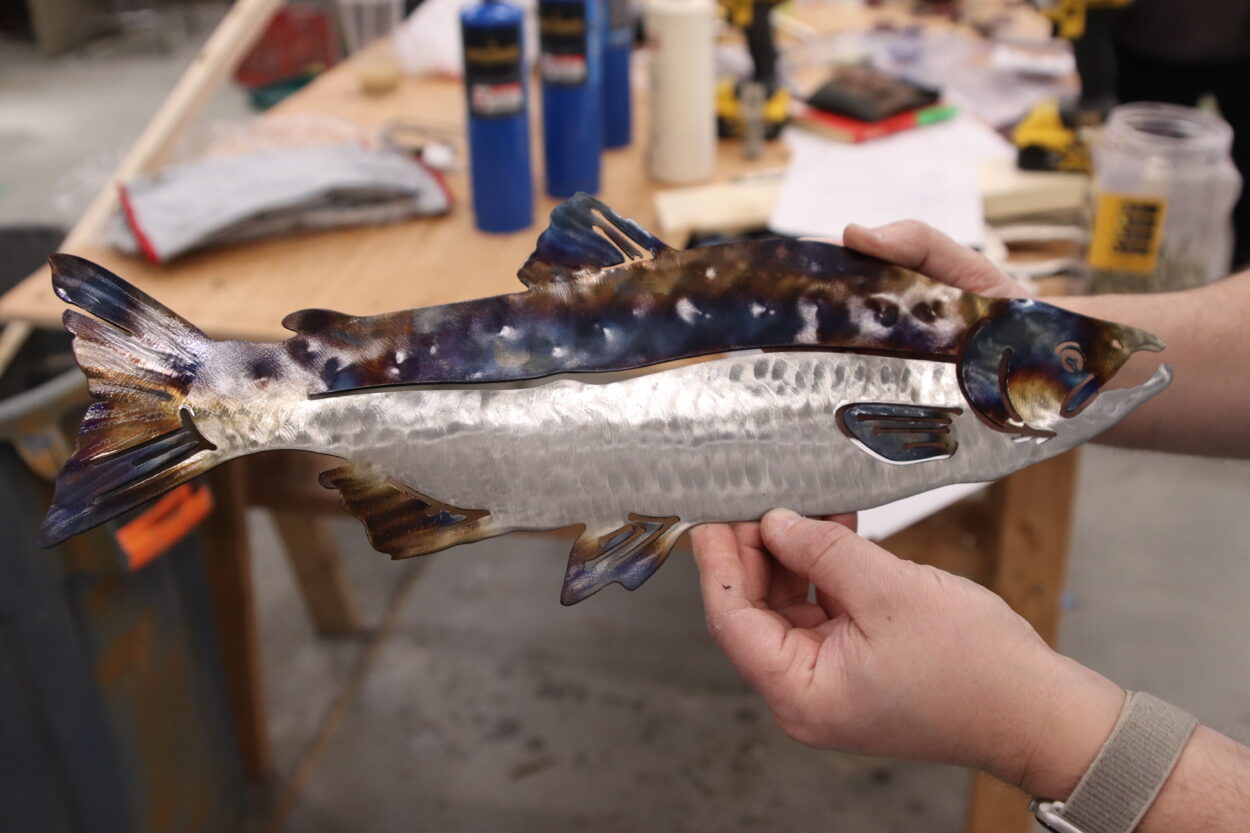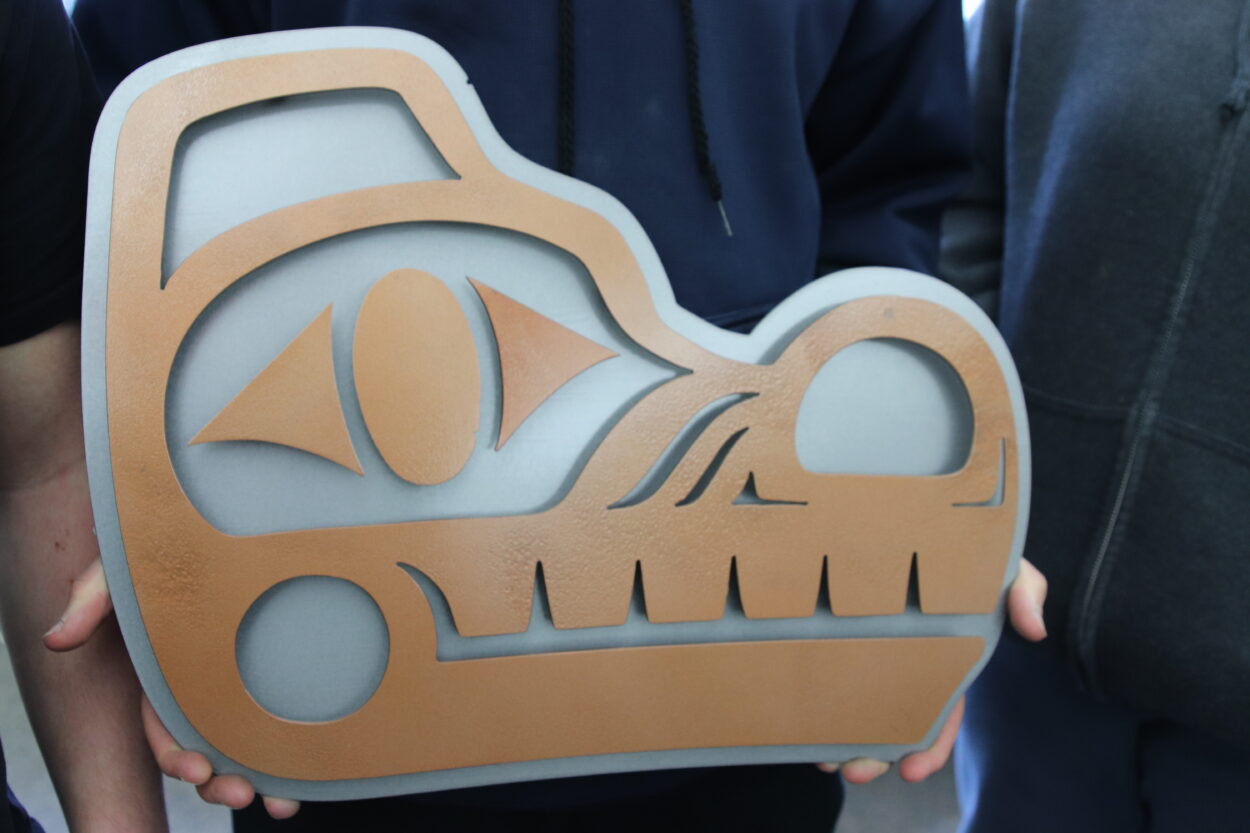
A grant-funded program at Sitka High School is active again, after a two-year setback during the pandemic. Students in Career and Technical Education classes are getting hands-on experience working with equipment that could take their skills to the next level – literally – and launch them into jobs in the aerospace industry.
High school shop class brings all sorts of images to mind – I’m sure many see it as “The Breakfast Club” for kids who don’t quite fit in elsewhere, a mix of motorheads and woodworkers tearing apart rusty cars and nailing up backyard storage sheds.

But it’s long past time to drop that stereotype. Sitka High Career and Technical Education (CTE) teacher Mike Vieira is operating a $30,000 plasma cutter, a tool that takes a pattern or a drawing – it can be anything you can create on a computer screen – and cuts it precisely into rolled steel or other metal.
Vieira says CTE is not your grandfather’s shop class.
“Our goal is to produce students that are ready for high-demand, highly skilled, and high wage jobs,” Vieira said. “And the way that the world is turning — certainly there’s going to be large scale manufacturing — it’s returning to the small shops that are going to be able to output single use items. So one-offs of this and one-offs of that, and in order to do that, you’ve got to be able to enter with CAD (Computer-Aided Design), you got to be able to take your CAD file and output it to a device and tell it how to run its toolpath. And from that, and then it’s just limited to your imagination.”
Sitka’s CTE program won a $10,000 grant from BP in 2018 to support the purchase of this cutter, which moves an 85-amp plasma torch – that resembles an arc welder – over a broad, waist-high table. There’s a piece of steel on the table now with a couple of dozen shapes cut out of it, a cookie-cutter collection of salmon, sports logos, and house numbers – all designed by students.
“It’s a lot of fun,” said Nik Calhoun, a senior at Sitka High. “You get to learn how to computer program and through CAD, it’s really cool, actually.”

Calhoun shows me a bear’s head rendered in traditional NW Coast formline design, from a pattern drawn by Sitka artist Charlie Skultka, Jr. It’s about two-feet wide, painted tan, and mounted on a backing plate that will become part of a new sign outside of Sitka’s elementary school. It’s only his third or fourth project on the plasma cutter, and it looks like it could have come out of a professional shop.
“This one right here for Baranof (Elementary School),” Calhoun said. “It took me about a class-and-a-half. So it’s fairly quick.”
The beauty of the plasma cutter is contained in this piece of work: The school district would never commission a custom sign like this – it’s simply too expensive and time-consuming to craft by hand. The plasma cutter brings the efficiency of a manufactured process to producing something very unique. And this is an extraordinary way to approach new designs – just like high-end manufacturers like Boeing are doing now.

“We’re fortunate to be one of 40 Boeing partner schools,” said Matt Johnson, a visiting CTE from Snohomish High School. “And we have a, a curriculum called Core Plus Manufacturing, which is an aerospace and advanced manufacturing focused curriculum that was developed in part by Boeing and some of their major vendors that work along with them. And students earn an industry recognized certificate at the end of my class. And if they have that certificate, Boeing has said ‘We guarantee you get an interview.’”
Johnson was the 2018 CTE Teacher of the Year in Washington state. Mike Vieira met Johnson through social media, applied for funding from New Visions, a program of the Alaska State Council on the Arts and the National Endowment for the Arts, and offered him an invitation to Sitka for three days this spring to train Sitka’s CTE faculty on the cutter, and to work with students, who see shop class now with different eyes.
“So in my school, that plasma cutter, it’s the workhorse,” said Johnson. “It’s almost an instant gratification machine where kids can take an idea, put it on to a computer screen, and and only minutes later have something that they can then be able to grind and work with and apply color, and have something tangible. So it’s a great way to step into a low risk way of making things that’s really precise. And then we can build from there, because I teach aerospace skills and and where do we go from there. So for my school, that plasma cutter is where we are able to hook the kids into these projects.”
“I was working on an inlay, yeah an inlay wood project on the CNC router,” said student Tyler Barton, reflecting on what he was doing before the arrival of the cutter. “And now I’m gonna move on to this plasma cutter. I’ve already cut two products projects on it.”

Tyler Barton is also a senior. He transitioned from wood to metal when the cutter arrived. But he’s not planning to use the skills professionally. He’s headed to college, and the cutter helps him see what’s possible
“I took this class because I want to be an engineer,” he said. “And I thought this would be an interesting class, seeing a lot of computer stuff. I could definitely do this as a hobby. I would love to do this as a hobby.”
And my editorial observation that remark is: Wilbur and Orville Wright were bike mechanics, whose hobby was airplanes.
Before I leave the CTE building, instructor Mike Vieira tells me that working with Matt Johnson has been one of his best days teaching – a chance for his students to see that learning never stops.
“I just kind of handed my classes off to him,” said Vieira, “and I am just a student alongside my students, which I think is is fun for me and fun for my students to see me in that role.”






























